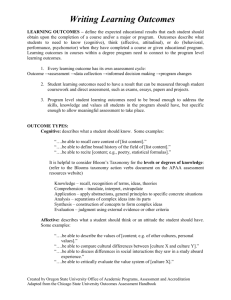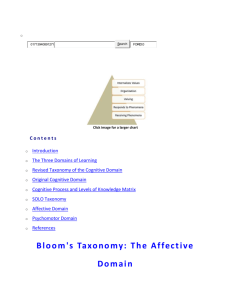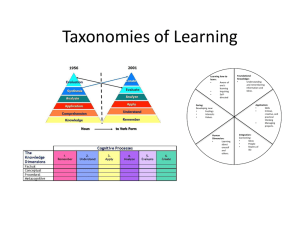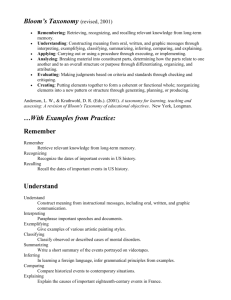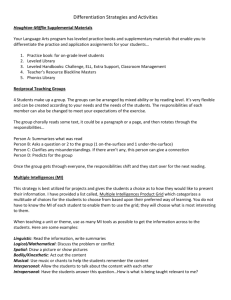Learning Taxonomies - Definitions and Key Words
advertisement
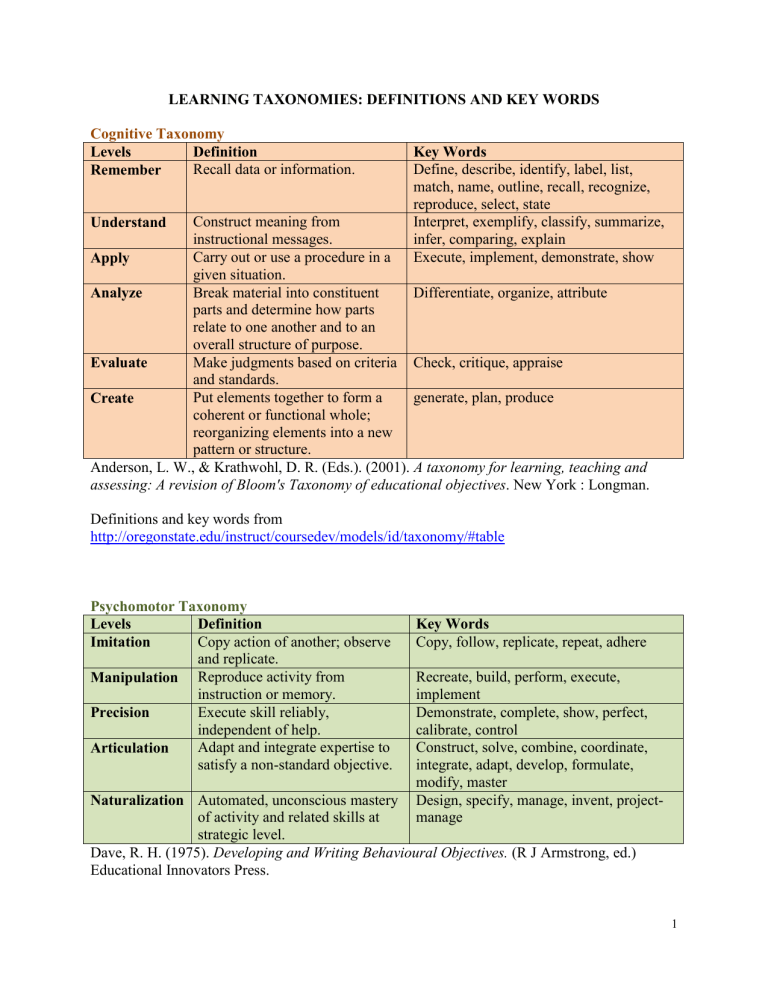
LEARNING TAXONOMIES: DEFINITIONS AND KEY WORDS Cognitive Taxonomy Levels Definition Recall data or information. Remember Key Words Define, describe, identify, label, list, match, name, outline, recall, recognize, reproduce, select, state Interpret, exemplify, classify, summarize, infer, comparing, explain Execute, implement, demonstrate, show Construct meaning from instructional messages. Carry out or use a procedure in a Apply given situation. Break material into constituent Differentiate, organize, attribute Analyze parts and determine how parts relate to one another and to an overall structure of purpose. Make judgments based on criteria Check, critique, appraise Evaluate and standards. Put elements together to form a generate, plan, produce Create coherent or functional whole; reorganizing elements into a new pattern or structure. Anderson, L. W., & Krathwohl, D. R. (Eds.). (2001). A taxonomy for learning, teaching and assessing: A revision of Bloom's Taxonomy of educational objectives. New York : Longman. Understand Definitions and key words from http://oregonstate.edu/instruct/coursedev/models/id/taxonomy/#table Psychomotor Taxonomy Levels Definition Copy action of another; observe Imitation and replicate. Manipulation Reproduce activity from instruction or memory. Execute skill reliably, Precision independent of help. Adapt and integrate expertise to Articulation satisfy a non-standard objective. Key Words Copy, follow, replicate, repeat, adhere Recreate, build, perform, execute, implement Demonstrate, complete, show, perfect, calibrate, control Construct, solve, combine, coordinate, integrate, adapt, develop, formulate, modify, master Design, specify, manage, invent, projectmanage Naturalization Automated, unconscious mastery of activity and related skills at strategic level. Dave, R. H. (1975). Developing and Writing Behavioural Objectives. (R J Armstrong, ed.) Educational Innovators Press. 1 Definitions and key words from http://www.businessballs.com/bloomstaxonomyoflearningdomains.htm#bloom's%20affective%2 0domain Affective Taxonomy Levels Definition Key Words Awareness, willingness to hear, Asks, chooses, describes, follows, gives, Receives selected attention. holds, identifies, locates, names, points to, phenomena selects, sits, erects, replies, uses Active participation on the part of Answers, assists, aids, complies, conforms, Responds to the learners. Attends and reacts to discusses, greets, helps, labels, performs, phenomena a particular phenomenon. practices, presents, reads, recites, reports, Learning outcomes may selects, tells, writes emphasize compliance in responding, willingness to respond, or satisfaction in responding. The worth or value a person Completes, demonstrates, differentiates, Values attaches to a particular object, explains, follows, forms, initiates, joins, phenomenon, or behavior. This justifies, proposes, reads, reports, selects, ranges from simple acceptance to shares, studies, works the more complex state of commitment. Valuing is based on the internalization of a set of specified values while clues to these values are expressed in the learner’s overt behavior and are often identifiable. Organizes values into priorities Adheres, alters, arranges, combines, Organizes by contrasting different values, compares, completes, defends, explains, resolving conflicts between them, formulates, generalizes, identifies, and creating an unique value integrates, modifies, orders, organizes, system. The emphasis is on prepares, relates, synthesizes comparing, relating, and synthesizing values. Has a value system that controls Acts, discriminates, displays, influences, Internalizes their behavior. The behavior is listens, modifies, performs, practices, values pervasive, consistent, predictable, proposes, qualifies, questions, revises, and most importantly, serves, solves, verifies characteristic of the learner. Instructional objectives are concerned with the student's general patterns of adjustment (personal, social, emotional). Krathwohl, D. R., Bloom, B. S., & Masia, B. B. (1973). Taxonomy of educational objectives, the Classification of educational goals. Handbook II: Affective domain. New York: David McKay Co., Inc. Definitions and key words from http://www.nwlink.com/~donclark/hrd/bloom.html 2

